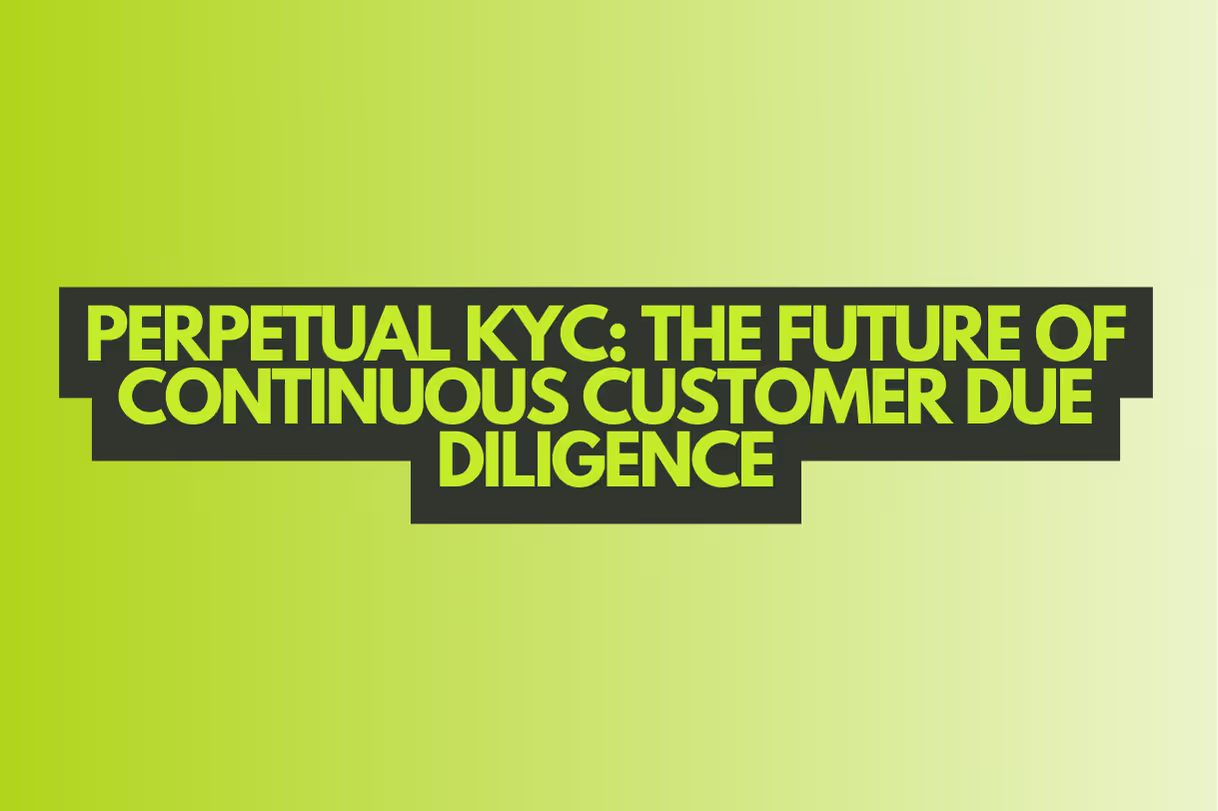
Perpetual KYC: The Future of Continuous Customer Due Diligence
Discover how perpetual KYC transforms customer due diligence with real-time risk insights, fraud detection, and AML compliance. Learn more today.
As regulatory expectations tighten and financial crime evolves, perpetual KYC (Know Your Customer) has emerged as a critical evolution in the compliance lifecycle. Unlike periodic KYC, which only updates customer profiles at fixed intervals, perpetual KYC enables continuous customer due diligence (CDD) through real-time monitoring and automation.
This shift is particularly relevant for fintech and regtech firms navigating the complexities of fraud risk management, anti-money laundering compliance, and scalable onboarding processes. This article explores how perpetual KYC is redefining compliance, improving risk accuracy, and reducing costs.
What Is Perpetual KYC (pKYC)?
Perpetual KYC refers to an automated, always-on approach to monitoring customer risk profiles. It leverages technologies such as APIs, artificial intelligence (AI), and machine learning (ML) to continually assess data for risk signals.
This model contrasts with traditional CDD vs EDD (enhanced due diligence) approaches, which are typically triggered by static rules or time-based reviews—often resulting in outdated information and potential compliance gaps.
The Difference Between KYC and Perpetual KYC
KYC (Know Your Customer):
Traditional KYC is a process used by financial institutions and other regulated entities to verify the identity of customers. It is typically conducted during customer onboarding and at set intervals thereafter—such as annually or every few years. This process is often manual, document-heavy, and reactive. It can create compliance gaps if a customer’s risk profile changes between scheduled reviews.
Example:
A bank may request updated proof of address and ID from a customer every 12 months as part of a periodic KYC refresh.
Perpetual KYC (pKYC):
Perpetual KYC refers to a continuous, real-time or near real-time monitoring approach that updates customer profiles dynamically. It leverages automation, third-party data sources, and technologies such as AI to detect changes in customer information or risk status as they occur. This proactive model reduces the need for periodic manual reviews and improves both operational efficiency and compliance.
Example:
If a customer’s ownership structure or directorship changes, a pKYC system would detect the update through automated data feeds and trigger a risk reassessment immediately.
Benefits of Perpetual KYC
Implementing a perpetual KYC model offers several advantages over traditional, periodic customer due diligence processes. Here’s a closer look at the key benefits:
Real-Time Risk Visibility
Perpetual KYC provides continuous monitoring of customer data, enabling firms to detect risk changes as they happen, not months or years later. Whether it’s a new sanction listing, a change in beneficial ownership, or emerging adverse media, compliance teams gain instant visibility into potential threats.
This real-time risk visibility ensures institutions can make informed decisions faster, minimizing exposure to financial crime and enhancing overall customer risk management.
Automated Alerts for High-Risk Behaviors
Rather than relying on manual reviews or outdated risk models, perpetual KYC uses automation to flag suspicious or unusual activity. Triggers may include:
- Transactions inconsistent with a customer’s profile
- Associations with high-risk jurisdictions
- Sudden changes in ownership structure
These automated alerts empower compliance teams to act swiftly—initiating enhanced due diligence (EDD), escalating to investigators, or freezing accounts when necessary. The result is a more proactive approach to fraud risk management and financial crime prevention.
Regulatory Readiness
Global regulatory bodies increasingly favor dynamic, risk-based approaches to due diligence. By adopting a perpetual KYC framework, organizations align with evolving expectations from authorities such as FATF, FinCEN, and the European AMLA.
When regulators conduct audits or compliance assessments, firms using perpetual KYC can demonstrate:
- A clear audit trail of monitoring activities
- Evidence of ongoing risk assessments
- Adherence to anti-money laundering compliance frameworks
This leads to stronger regulator trust, fewer penalties, and better resilience in the face of changing rules.
Operational Cost Reduction
Although perpetual KYC requires initial investment in technology and data integration, it ultimately reduces long-term operational costs by:
- Minimizing manual reviews and re-verification cycles
- Reducing false positives and investigative time
- Streamlining onboarding and remediation workflows
Firms can reallocate resources to higher-value tasks, reduce compliance staffing costs, and scale more efficiently—especially in high-growth environments or cross-border operations.
Why the Traditional KYC Model Falls Short
In the traditional model, KYC is performed at onboarding and then revisited every 1–3 years, depending on risk levels. This leaves large gaps in risk visibility. If a customer suddenly appears on a sanctions list or changes beneficial ownership, these shifts may go unnoticed for months.
Fraud risk management becomes reactive rather than proactive. Bad actors can exploit these gaps, exposing institutions to hefty fines and reputational damage.
For example, in a recent enforcement action, regulators penalized a global financial institution for failing to detect a sanctioned individual due to outdated KYC data. A perpetual model would have flagged this change in near real-time.
Key Technologies Powering Perpetual KYC
To implement perpetual KYC effectively, firms must integrate a tech stack capable of real-time data ingestion and analysis. Common components include:
1. Real-Time Data Feeds
Sanctions lists, politically exposed persons (PEP) databases, adverse media, and transaction data are monitored 24/7 to detect anomalies or red flags.
2. Workflow Automation
Trigger-based workflows ensure alerts lead to appropriate actions, whether that’s rerunning identity checks or escalating to human review.
3. AI & Machine Learning
Advanced algorithms identify risk patterns over time, helping to distinguish false positives from real threats—enhancing financial crime prevention efforts.
{{snippets-guide}}
Regulatory Expectations and Compliance
Global regulators—including the FATF, FinCEN, and EU AMLA—are signaling increased support for dynamic risk assessments and perpetual KYC. This aligns with evolving anti-money laundering compliance standards that prioritize ongoing vigilance over checkbox exercises.
In 2021, the FATF released guidance recommending real-time monitoring as a best practice, especially for high-risk sectors like cryptocurrency, cross-border payments, and digital banking.
As regulators shift toward a risk-based approach, organizations that adopt perpetual KYC will be better positioned for audits and supervisory reviews.
Benefits for Fintech and Regtech Firms
For digital-first businesses—particularly fintechs, neobanks, crypto platforms, and regtech providers can have significant benefits:
Faster Onboarding
A major source of drop-off in the customer journey is friction during onboarding. Traditional KYC models often require manual documentation checks, repeated ID verification, and long turnaround times—especially for returning customers or low-risk profiles.
With perpetual KYC:
- Dynamic risk scoring allows firms to skip unnecessary steps for stable, low-risk customers.
- Customers benefit from streamlined sign-up experiences, improving conversion rates and reducing abandonment.
- Compliance teams avoid re-collecting data already validated unless triggered by a risk change.
The result is a smoother, faster onboarding process—critical for customer satisfaction and acquisition in competitive digital markets.
Scalability Without Headcount Growth
As fintech and regtech businesses expand across geographies, customer segments, and regulatory regimes, traditional KYC processes struggle to keep up. Perpetual KYC offers a scalable framework by automating:
- Ongoing monitoring and re-screening
- Sanctions and PEP list checks
- Adverse media analysis
- Workflow routing based on risk profiles
This automation allows organizations to scale operations without proportionally increasing compliance headcount, a key advantage for fast-growing startups and lean compliance teams.
Perpetual KYC can be easily localized to meet jurisdiction-specific requirements, making it ideal for multi-market expansion.
Customer Trust Through Transparency and Security
In a climate of rising digital fraud, data breaches, and regulatory scrutiny, trust is currency. Customers expect financial institutions to protect their data and ensure transactions are secure—but without adding friction.
By implementing perpetual KYC:
- Organizations signal transparency, diligence, and accountability, building confidence among users and partners.
- Customers are protected in real time from being unknowingly involved in fraud or money laundering networks.
- Companies can proactively communicate their compliance measures, enhancing reputation and brand equity.
Trust isn’t just a compliance outcome—it becomes a competitive differentiator.
Strategic Advantage in the Compliance-First Era
By embracing perpetual KYC, fintechs and regtechs stay ahead of regulatory expectations. Real-time due diligence becomes a core part of the business model, enabling:
- Faster market entry
- Stronger banking-as-a-service partnerships
- Greater investor confidence
In an environment where regulatory agility is as critical as product-market fit, perpetual KYC sets digital-first companies apart—making them more resilient, efficient, and trustworthy.
Challenges and How to Overcome Them
1. Data Integration
Accessing accurate and real-time data from multiple jurisdictions can be difficult. Investing in high-quality data providers is crucial.
2. False Positives
Too many alerts can overwhelm compliance teams. Implementing machine learning to prioritize high-risk cases is key.
3. Cost and Change Management
Switching to a perpetual KYC model may require system overhauls. Start with a phased approach—pilot with high-risk segments and scale from there.
Challenges of Perpetual KYC—and How to Overcome Them
While the advantages of perpetual KYC are significant, transitioning from a static compliance model isn’t without its hurdles. Digital-first organizations must navigate technical, operational, and strategic obstacles to ensure a successful implementation. Here’s how to approach the most common challenges:
1. Data Integration Across Jurisdictions
The Challenge:
erpetual KYC relies on accurate, real-time access to a wide variety of data sources—sanctions lists, PEP registries, adverse media, beneficial ownership records, and more. Aggregating this information from multiple jurisdictions, each with varying data standards, formats, and update frequencies, is a complex task.
The Solution:
- Partner with reputable, high-accuracy data providers like sanctions.io that specialize in global regulatory data aggregation.
- Use API-driven integrations to ensure seamless, real-time data feeds into your compliance engine.
- Apply data normalization frameworks to reconcile information from disparate sources into consistent, actionable formats.
Investing in the right data architecture early on creates the foundation for sustainable, scalable financial crime prevention and anti-money laundering compliance operations.
2. Managing False Positives and Alert Fatigue
The Challenge:
One downside of continuous monitoring is the potential for excessive alerts—many of which may not indicate true risk. If left unchecked, this false positive overload can overwhelm compliance teams, delay investigations, and increase operational costs.
The Solution:
- Integrate machine learning models that learn from past investigation outcomes and adjust risk thresholds dynamically.
- Implement risk-based prioritization frameworks that escalate only alerts tied to significant behavioral changes or high-risk entities.
- Use feedback loops to continuously refine and tune detection rules based on actual outcomes.
The goal isn’t to eliminate false positives entirely; it’s to reduce noise and sharpen focus so that critical risks aren’t buried in low-priority alerts.
3. Cost and Change Management
The Challenge:
Transitioning to a perpetual KYC framework often requires rethinking legacy systems, retraining teams, and aligning internal stakeholders. For many organizations, the upfront cost of technology investment and organizational change can appear daunting.
The Solution:
- Start with a phased rollout, targeting high-risk customer segments where real-time monitoring yields the greatest ROI.
- Use early pilot success stories to build internal momentum and stakeholder buy-in.
- Align your tech investment with long-term savings from automated processes, fewer fines, and improved customer experience.
Many fintechs and regtechs find that the initial costs are offset quickly by gains in operational efficiency, improved compliance posture, and faster time-to-market in new regions.
{{snippets-case}}
Conclusion: Perpetual KYC
Perpetual KYC is the future of continuous customer due diligence. As regulatory landscapes shift and fraud threats become more sophisticated, only those organizations with a dynamic, always-on compliance approach will be equipped to thrive.
By leveraging fraud risk management tools, embedding anti-money laundering compliance workflows, and strengthening financial crime prevention, perpetual KYC empowers firms to turn compliance from a cost center into a strategic advantage.
To find out how we can support your pKYC efforts, get in touch with sanctions.io today. We also encourage you to take advantage of our free 7-day trial to get started with your sanctions and AML screening (no credit card is required).



